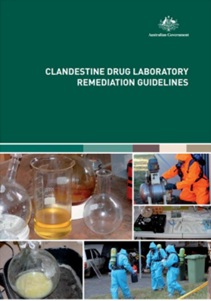Clandestine Laboratory Testing
Testing homes for contamination from clandestine drug laboratories (clan labs) and associated activities, such as drug smoking or growing, is critical for ensuring public health and safety, maintaining property value, and addressing legal and environmental responsibilities.
Health Risks
Residues from the manufacture and use of illicit drugs like methamphetamines can persist in homes, posing significant health risks to occupants. Exposure can occur via inhalation, skin contact, or ingestion and may lead to symptoms such as respiratory issues, skin rashes, behavioural changes and sleep disturbances. Long-term exposure increases risks for severe conditions, including organ damage and developmental issues in children.
Persistence of Contamination
Contaminants from clan labs, including volatile organic compounds (VOCs), toxic metals (e.g. lead and mercury) and methamphetamine residues, often become embedded in porous materials like carpets, plasterboards and concrete. These residues are resistant to conventional cleaning methods and may persist indefinitely if not addressed.
Environmental and Structural Impacts
Chemical spills and waste dumping from clandestine drug manufacturing often lead to soil and water contamination. Indoors, improper ventilation or the use of corrosive chemicals can cause structural damage, including corroded plumbing and electrical faults, further increasing remediation costs.
Testing Protocols
Testing is essential to identify contamination, particularly in properties suspected of having been used as clan labs, smoke houses, or grow houses. Standard methods include:
Surface Testing: Wipe samples from horizontal non-porous surfaces, particularly in kitchens, bathrooms, and bedrooms, where contamination levels are likely highest.
Air Sampling: To test indoor air quality and to identify the presence of VOCs.
Moisture and Structural Analysis: To identify damage and contamination embedded in building materials. This may lead to a Mould Assessment being recommended, prior to remediation works.
Legal and Financial Considerations
In some jurisdictions, landlords and property owners are legally obligated to disclose contamination and remediate properties before leasing or selling. Failure to do so may result in legal action. Remediation costs can range from $25,000 to $150,000, depending on the extent of contamination and structural damage.
In conclusion, testing homes for contamination from clandestine drug activities is a crucial step in safeguarding health, ensuring compliance with environmental standards, and protecting property investments. Early detection and appropriate remediation prevent prolonged exposure and reduce overall risks to occupants and communities.
On-site testing is billed at $110 / hour plus $33 per test kit used.



